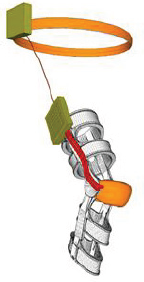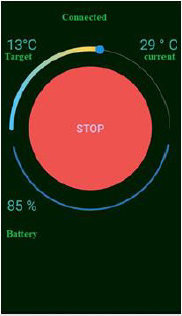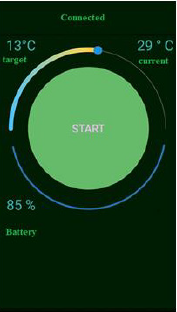Application of Thermal Orthosis to Knee Joint Treatment
Methodology
Knee joint orthesis was designed for patients with injuries, after surgical procedures or patients in chronic pain. In such cases orthoses are very helpful [1]. The designed device may be used in the cryotherapy of the knee joint. Cryotherapy is applied in the cases of post-traumatic conditions, inflammatory and degenerative disorders as well as oedema of the joints [2-4]. The main objective of the project was to develop an integrated module for cryotherapy combined with the knee joint orthosis. The Peltier module was used as the element for cooling the liquid. Another goal of the project was to create an application enabling the control of the cooling system (e.g. liquid temperature, cooling system operation). The developed application works in the Android operation system. An important criterion was also the provision of the utmost comfort of use of the equipment. To achieve this, electronic elements and the cooling system were placed in additional casings, which were attached to the hip belt and to the additional cover located on the patient’s thigh (Figure 1).
An essential issue of the designing process was to find
the material which would meet certain requirements, such
as leakproofness – impermeability of the cooling liquid, nonirritability.
The project made use of the Peltier module in order
to ensure proper temperature. The operation of such modules
consists in the application of the technology of the electric current
flow through semiconductor junctions. The material of the abovementioned
semiconductors was selected in such a way as to ensure
that junction N would have excess of electrons, whereas junction
P would have their shortage. Semiconductors N and P were
alternately placed causing the flowing current to ‘force’ electrons
to absorb heat energy from the surroundings (junction N-P). This
process results in the cooling of one side of the module. The junction
polarised in an opposite direction gives up heat to the surroundings
warming the other side of the device.
There are many solutions and methods of mounting the Peltier
modules in cooling systems. The most popular are as follows:
a) System of the Peltier modules in parallel,
b) System with active cooling of the module,
c) System with passive cooling of the module,
d) System with water cooling.
To control the orthosis, an application was designed. Thanks to the application, it is possible to start the operation of the device, turn it off and change the preset temperature. The application operates in the Android system and has wireless communication with the device (by means of the Bluetooth interface). The main reason for applying this type of communication was the availability of modules – each contemporary mobile phone with the Android system has the Bluetooth module. In order to perform tests checking wireless communication, a prototype of the application was created. The programming environment made use of a freeof- charge MIT App Inventor generator, which is made available by the Massachusetts Institute of Technology. The interface of this environment enables the development of applications by merger of instruction units. The final version of the application was made using the official software programme Android Studio supplied by the Google company. The designed application has a simple and easy-to-use interface (Figures 2 & 3). The prototype of the casing of the cryotherapy module was made using a 3D printer.
The Developed Unit Can Be Further Expanded
The existing function of relieving pain by means of cooling may be supplemented with a separate heating system, which can be used accordingly when required by the rehabilitation therapy. The choice of either cooling or heating mode will contribute to greater universality of the device.
For more Articles on : https://biomedres01.blogspot.com/





No comments:
Post a Comment
Note: Only a member of this blog may post a comment.